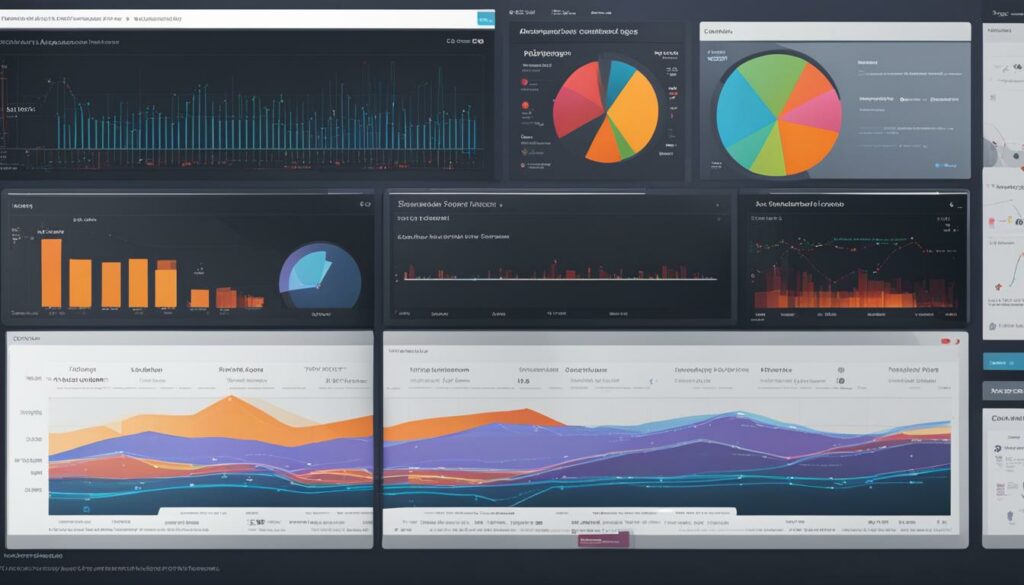Setting up and running a website is important for any business. Monitoring your website’s status is crucial to identify potential problems and ensure optimal performance. There are various tools and strategies available for web server log management, including log analysis tools, log file analysis, log file management, log file monitoring, log file retention, log file security, log file backup, and log file reporting. By effectively managing your web hosting logs, you can optimize site performance, improve security, and streamline troubleshooting.
Key Takeaways:
- Managing web hosting logs is essential for optimizing site performance and improving security.
- Log analysis tools help analyze log files and identify potential issues.
- Monitoring log files allows for real-time detection and troubleshooting of website problems.
- Retaining log files helps with performance trend analysis and continuous improvement.
- Backing up log files ensures data preservation and facilitates disaster recovery.
We recommend WordPress Hosting from BoostedHost for optimal performance. Sign up now through this link: www.boostedhost.com/wordpress-hosting.
Why Monitoring Your Website is Important
In today’s digital age, having a website is crucial for any business. However, simply having a website is not enough. It’s essential to monitor your website regularly to ensure its smooth operation and optimal performance. Website monitoring allows you to keep an eye on various aspects of your site, detect potential problems, and take necessary actions to resolve them promptly.
Monitoring your website involves tracking key metrics such as uptime, response time, and performance. By monitoring these factors, you can proactively identify and address issues before they impact your visitors’ experience or your business’s reputation.
Here are some important reasons why monitoring your website is a must:
1. Monitor Potential Problems
Website monitoring enables you to stay informed about any potential problems that may arise. By receiving alerts and notifications, you can quickly respond to issues and minimize their impact on your site’s performance. Whether it’s a server outage, database connection error, or a sudden spike in traffic, monitoring helps you identify and address these issues promptly.
2. Performance Monitoring
Monitoring your website’s performance allows you to understand how it behaves under different conditions and loads. By tracking metrics like page load times, server response times, and resource utilization, you can optimize your site for better user experience and faster loading speeds. This, in turn, increases user satisfaction, reduces bounce rates, and improves overall conversion rates.
3. Uptime Monitoring
Uptime is a critical metric that indicates the amount of time your website remains accessible to users. Downtime can lead to frustrated visitors, lost sales, and a negative impact on your brand’s reputation. By using uptime monitoring tools, you can ensure that your site remains live and accessible at all times. This helps maintain customer trust and confidence in your business.
“Monitoring your website’s uptime is like having a watchful guardian that ensures your online presence is available and open 24/7, protecting your business and reputation.”
4. Response Time Monitoring
Response time is the time it takes for your website to load and respond to user requests. Slow response times can frustrate visitors and lead to high bounce rates. By monitoring response times, you can identify bottlenecks or performance issues and take steps to optimize your site’s speed and responsiveness.
5. Data Backup Monitoring
Data backup is crucial for protecting your website and its valuable content. It ensures that you have a copy of your website’s files and databases in case of any data loss scenarios, such as server crashes, hacking attempts, or accidental deletions. Monitoring data backup status ensures that your backups are being created successfully and can be restored if needed.
By regularly monitoring your website, you can proactively detect and resolve any issues that may arise, ensuring the smooth functioning of your site and providing visitors with a seamless and enjoyable user experience. It also helps you protect your brand’s online reputation, retain customers, and drive business growth.
Remember, the key to effective website monitoring is choosing the right tools and implementing a comprehensive monitoring strategy that covers all critical aspects of your site’s performance. Take the necessary steps today to monitor and safeguard your website’s success.
| Benefits of Website Monitoring | Why Monitoring Your Website is Important |
|---|---|
| Early detection and resolution of potential issues | Detect and address potential problems in real-time |
| Improved site performance and user experience | Ensure optimal uptime and response time |
| Prevent loss of revenue and customer trust | Protect your business’s reputation |
| Efficient data backup and restoration | Ensure the ability to recover quickly |
Tools and Strategies for Monitoring Your Website
Monitoring your website is crucial to ensure optimal performance and address potential issues in real-time. Fortunately, there are several tools and strategies available to help you effectively monitor and analyze your website’s performance. Whether you’re using a web hosting company’s tools or leveraging third-party monitoring services, implementing the right tools and strategies is essential for maintaining a high-performing website.
When it comes to web hosting company tools, many providers offer built-in monitoring and logging features as part of their hosting packages. These tools can be invaluable for tracking your website’s uptime and performance. For example, ping tests are often included, allowing you to perform simple up/down tests on your site to ensure it’s running smoothly and responding to requests.
In addition to basic testing, it’s important to monitor multiple pages on your site to ensure overall functionality. By keeping an eye on different pages and functionalities, you can quickly identify any potential issues that may arise. This proactive approach helps you maintain a seamless user experience and resolve problems promptly.
Collecting data from various monitoring tools allows you to perform trend analysis and gain valuable insights into your website’s performance. By analyzing trends over time, you can identify patterns, spot potential bottlenecks, and make informed decisions to optimize your site’s uptime and overall performance.
While many web hosting companies offer monitoring tools, there are also third-party monitoring solutions available. These tools specialize in website monitoring services and often provide more advanced features. From real-time alerts to comprehensive reporting, third-party monitoring tools offer additional functionalities to enhance your monitoring capabilities.
Choosing the right monitoring tools for your specific needs is crucial. Consider factors such as the size and complexity of your website, the level of support and customization you require, and your budget. Some monitoring tools offer free options, while others provide more robust features in paid plans. Exploring your options and doing research will help you find the perfect fit for your website monitoring needs.
Overall, utilizing appropriate tools and implementing effective strategies for monitoring your website is essential for maintaining its optimal performance. By actively monitoring your site, you can proactively detect and address any issues, ensuring a seamless user experience and preserving your business’s reputation.
Table: Comparison of Web Hosting Company Tools and Third-Party Monitoring Tools
| Features | Web Hosting Company Tools | Third-Party Monitoring Tools |
|---|---|---|
| Ping Tests | ||
| Monitoring Multiple Pages | ||
| Collecting Data for Trend Analysis | ||
| Price | Varies | Varies |
Note: This table provides a comparison of the features offered by web hosting company tools and third-party monitoring tools. It is important to carefully evaluate the specific functionalities and prices offered by different providers to choose the most suitable option for your website monitoring needs.
Importance of Apache Logs for Website Troubleshooting
Apache logs are an essential tool for troubleshooting and optimizing your website’s performance. By analyzing Apache logs, you gain valuable insights into your web operations, including traffic volume, errors, and server performance metrics. This information allows you to identify issues and make informed decisions to enhance your website’s functionality and user experience.
One key benefit of Apache logs is their ability to help you troubleshoot web applications. By reviewing error message logs, you can quickly identify and resolve any issues affecting your website’s performance. This ensures that your web applications are running smoothly and improve overall user satisfaction.
Monitoring traffic volume through Apache logs is another crucial aspect of optimizing your website’s performance. By tracking the traffic volume, you can assess the load on your server and make necessary adjustments to ensure optimal server performance. This data also helps you make informed decisions about scaling your website hosting resources to accommodate growing traffic.
Optimizing website performance based on Apache logs is vital for ensuring a seamless user experience. By analyzing the logs, you can identify potential bottlenecks or areas for improvement and implement changes to enhance your website’s speed and responsiveness. This optimization enhances user satisfaction and encourages them to spend more time on your website.
Overall, Apache logs provide you with valuable insights into your website’s performance, allowing you to troubleshoot web applications, monitor traffic volume, and optimize your website for improved performance. By leveraging the power of Apache logs, you can ensure a smooth and efficient browsing experience for your users.

Stay tuned for the next section, where we will explore how to effectively monitor Apache logs using Unix command-line tools.
Monitoring Apache Logs Using Unix Command-Line Tools
When it comes to monitoring Apache logs, Unix command-line tools offer a powerful and efficient solution. These tools provide valuable insights into website performance, error tracking, and access monitoring. By leveraging Unix command-line tools, you can effectively analyze and troubleshoot Apache logs, ensuring your website runs smoothly.
Accessing Apache Logs
To access Apache logs, you can navigate to specific directories that store the log files. The most common directories are /var/log/apache/access.log or /var/log/apache2/access.log. These files contain important information about user requests, server responses, and website interactions.
Monitoring Error Logs
Error logs play a crucial role in identifying and resolving website issues. To monitor error logs in real-time, you can use the tail command with the -f flag. This command allows you to track errors as they occur, enabling prompt troubleshooting and resolution of any issues impacting your website’s performance.
Monitoring Access Logs
Monitoring access logs is essential to gain insights into user activity, website traffic, and resource usage. By using the same tail command with the -f flag, you can monitor access logs in real-time. This enables you to track user requests, identify potential bottlenecks, and optimize your website’s performance based on user behavior.
Setting Log Message Levels
Apache log files can be categorized into different levels, such as error, warning, or informational logs. By setting log message levels in Apache configuration files, you can specify which log categories to monitor more closely. This allows you to focus on the most relevant information and streamline troubleshooting efforts, saving time and improving efficiency.
To summarize, Unix command-line tools provide a powerful arsenal for monitoring Apache logs. By accessing Apache logs, monitoring error logs, monitoring access logs, and setting log message levels, you can proactively identify and address issues to maintain optimal website performance.
| Benefits of Monitoring Apache Logs Using Unix Command-Line Tools |
|---|
| Efficient and real-time monitoring of error logs |
| Insights into user requests and website performance |
| Ability to focus on the most relevant log categories |
| Streamlined troubleshooting and issue resolution |
Benefits of Viewing Apache Logs in a Readable Format
While Unix command-line tools provide valuable information from Apache logs, viewing logs in a console can be challenging due to the volume of data. However, there are log analysis platforms available that provide a more readable and user-friendly interface. These platforms allow you to analyze log data, debug errors, and gain deeper insights into website performance.
One such platform is SolarWinds Loggly. With Loggly, you can easily view Apache logs in a graphical representation, making it easier to identify patterns, anomalies, and potential issues. The user-friendly interface provides customizable dashboards and visualizations, allowing you to quickly analyze log data and make informed decisions.
Loggly’s log monitoring and analysis services can help you streamline troubleshooting and improve the overall management of your web hosting logs. By viewing Apache logs in a readable format, you can easily track website performance, identify error trends, and debug issues in real-time.
By utilizing log analysis platforms like Loggly, you can:
- Analyze log data to gain insights into website performance and user behavior
- Debug errors and identify their root causes more efficiently
- Monitor logs in real-time to proactively address potential issues
- Set up alerts and notifications for critical log events
- Customize dashboards to track specific log metrics
Understanding Loggly’s Features
Loggly offers a range of features that simplify log analysis:
| Feature | Description |
|---|---|
| Search Functionality | Easily search and filter log data to find specific events or patterns |
| Alerts and Notifications | Set up alerts to notify you of critical log events or anomalies |
| Interactive Dashboards | Create customized dashboards to visualize log data and track key metrics |
| Real-time Log Streaming | Monitor logs as they are generated in real-time |
| Integration with DevOps Tools | Seamlessly integrate Loggly with your existing DevOps tools and workflows |

By viewing Apache logs in a readable format using log analysis platforms like Loggly, you can make informed decisions, streamline troubleshooting, and optimize your website’s performance. Sign up for BoostedHost’s WordPress Hosting, and take advantage of Loggly’s powerful log monitoring and analysis services.
Importance of Troubleshooting Website Issues
Troubleshooting website issues is crucial for maintaining the optimal functionality of your website. By identifying the root causes of errors, you can effectively resolve the issues and prevent them from occurring in the future. This not only helps minimize downtime but also ensures that your website is accessible to visitors, preserving your business reputation.
Addressing and resolving website issues promptly is essential for providing a positive user experience and maintaining the effectiveness of your online marketing efforts. In today’s digital landscape, where customers have high expectations, even small glitches can lead to a negative perception of your brand.
Effective website troubleshooting involves a systematic approach to identify, diagnose, and resolve any issues that may arise. By following best practices and utilizing appropriate tools, you can minimize the impact of errors and prevent them from recurring. This proactive approach saves time, resources, and helps preserve your business reputation.
Identifying Root Causes
When troubleshooting website issues, it is essential to identify the root causes rather than just addressing the symptoms. By digging deeper into the underlying issues, you can implement targeted solutions that mitigate the problem at its source. This prevents future errors and ensures a more stable and reliable website for your visitors.
Preventing Future Errors
Troubleshooting website issues is not just about fixing the current problem but also about preventing similar errors from occurring in the future. By analyzing the root causes, you can implement preventive measures, such as regular updates, security patches, and performance optimizations, to minimize the likelihood of future issues.
Minimizing Downtime
Website downtime can have a significant impact on your business. It not only frustrates visitors but also leads to lost opportunities, revenue, and potential customers. By promptly addressing website issues and resolving them efficiently, you can minimize downtime and ensure that your website remains accessible to your audience.
Preserving Business Reputation
Your website is often the first point of contact between your business and potential customers. A poorly functioning website can leave a negative impression and undermine your business reputation. By troubleshooting website issues and providing a seamless user experience, you can preserve your business’s reputation, build trust with your audience, and maintain a competitive edge in the online marketplace.
| Benefits of Troubleshooting Website Issues |
|---|
| Identifying and resolving root causes of errors |
| Preventing future errors |
| Minimizing website downtime |
| Preserving business reputation |
Having a proactive approach to troubleshooting website issues is crucial for maintaining the optimal performance and functionality of your website. By identifying root causes, preventing future errors, minimizing downtime, and preserving your business reputation, you can provide a positive user experience and ensure the success of your online presence.
10 Tips for Troubleshooting Website Issues
When it comes to troubleshooting website issues, you may encounter various problems that can affect the performance and accessibility of your site. Here are 10 tips and strategies to help you identify and resolve these issues:
- Check if the website is down: Start by verifying if your website is experiencing any downtime. This can be done by visiting your site and checking if it loads properly.
- Verify the internet connection: Ensure that your internet connection is working properly. Slow or unstable connections can lead to website loading issues.
- Clear browser cache: Sometimes, browser caching can cause website display problems. Clearing your browser cache can help resolve this issue.
- Check DNS records: Incorrect DNS records can result in website loading errors or DNS resolution problems. Verify your DNS settings to ensure they are configured correctly.
- Review error logs: Error logs provide valuable information about website issues. Check your server’s error logs to identify any error messages that may give clues about the problem.
- Utilize developer tools: Use developer tools like Chrome DevTools or Firebug to inspect and debug website elements. These tools can help you identify and fix code-related issues.
- Trace recent changes or updates: If the issue appeared after making recent changes or updates to your website, revert those changes and see if the problem persists. This can help isolate the cause of the issue.
- Consider using backups: If you have recent backups of your website, restoring a previous version can help resolve issues caused by recent changes or updates.
- Check for internet connection issues: Sometimes, website issues can be related to internet connection problems on the user’s end. Ensure that your visitors aren’t experiencing any connectivity issues.
- Seek professional help: If you’ve tried all of the above troubleshooting tips and are still facing issues, it may be time to seek help from a professional web developer or your hosting provider.
By following these tips, you can effectively troubleshoot and resolve various website issues, ensuring optimal performance and user experience for your visitors.
“Troubleshooting website issues can be challenging, but by following these tips, you can overcome obstacles and ensure your website runs smoothly.”
– Jamie Smith, Web Development Expert
Overview of Troubleshooting Steps
Troubleshooting website errors requires a systematic approach to effectively identify and resolve issues. Follow these steps to ensure the optimal functionality and user experience of your website:
1. Identifying Root Causes
To troubleshoot website errors, start by identifying the underlying causes. Analyze error messages, review server logs, and conduct thorough investigation to pinpoint the root causes of the issues.
2. Performing Temporary Code Modifications
Using developer tools, make temporary code modifications to test potential solutions. This allows you to isolate and validate the impact of different code changes on the website’s behavior.
3. Validating Recent Changes
If you’ve recently made any updates or changes to your website, validate their impact on the errors you’re experiencing. Roll back recent changes if necessary, and carefully test the functionality to ensure stability.
4. Utilizing Backups
In case of major issues or errors, having backups of your website is crucial for restoring previous versions. Regularly back up your website files, databases, and configurations to minimize potential downtime and data loss.
By following these troubleshooting steps, you can effectively resolve website errors, improve performance, and provide a seamless user experience.
| Troubleshooting Steps | Description |
|---|---|
| Identifying Root Causes | Analyze error messages, review server logs, and conduct investigation to identify the underlying causes of website errors. |
| Performing Temporary Code Modifications | Use developer tools to make temporary code changes and test different solutions for isolating and validating the impact on website behavior. |
| Validating Recent Changes | Check if recent updates or changes are causing errors, and roll back changes or conduct thorough testing to ensure stability. |
| Utilizing Backups | Maintain regular backups of your website files, databases, and configurations to easily restore previous versions in case of major issues or errors. |
Conclusion
Effective website troubleshooting is essential for optimizing site performance, resolving website issues, and maintaining the reputation of your business. By monitoring your web hosting logs, utilizing the right tools and strategies, and following a systematic approach to troubleshooting, you can proactively identify and resolve issues, ensuring a positive user experience and preserving the effectiveness of your online marketing efforts.
Troubleshooting website issues should be an ongoing process to continuously improve website performance and minimize downtime. You should regularly monitor your web hosting logs, analyze data, and utilize the appropriate tools to identify and resolve any issues that may arise. By taking these steps, you can optimize site performance, resolve any website issues promptly, and maintain a strong online presence.
For optimized performance and reliable website hosting, we recommend WordPress Hosting from BoostedHost. Sign up now through this link: www.boostedhost.com/wordpress-hosting. By choosing BoostedHost, you can benefit from their industry-leading hosting services and ensure that your website operates at its best.
FAQ
Q: What is the importance of monitoring your website?
A: Monitoring your website is crucial to identify potential problems and ensure optimal performance. It allows you to monitor the performance of your site, ensuring optimal uptime and response time. Additionally, monitoring data backup status helps ensure the ability to recover quickly in case of any issues.
Q: What tools and strategies can I use for monitoring my website?
A: There are various tools and strategies available for monitoring your website. Many web hosting companies provide tools for monitoring and logging as part of their hosting packages. These tools can include features such as ping tests, which perform simple up/down tests on your site to ensure it is running smoothly. Additionally, there are third-party tools available that specialize in website monitoring services.
Q: How can Apache logs help with website troubleshooting?
A: Apache logs play a crucial role in website troubleshooting and optimization. They provide valuable information about web operations, including traffic volume, errors, and server performance metrics. Analyzing Apache logs helps identify issues and optimize website performance.
Q: How can I monitor Apache logs using Unix command-line tools?
A: Monitoring Apache logs can be done using various Unix command-line tools. Accessing Apache logs can be done through specific directories such as /var/log/apache/access.log or /var/log/apache2/access.log. Monitoring error logs can be achieved by using the tail command with the -f flag, which displays the logs in real-time.
Q: What are the benefits of viewing Apache logs in a readable format?
A: While Unix command-line tools provide valuable information from Apache logs, there are log analysis platforms available that provide a more readable and user-friendly interface. These platforms allow you to analyze log data, debug errors, and gain deeper insights into website performance.
Q: Why is troubleshooting website issues important?
A: Troubleshooting website issues is crucial for maintaining the optimal functionality of a website. By identifying the root causes of errors, website owners can effectively resolve the issues and prevent them from occurring in the future, minimizing downtime and preserving the business’s reputation.
Q: What are some tips for troubleshooting website issues?
A: When troubleshooting website issues, some tips include checking if the website is down, verifying the internet connection, clearing browser cache, checking DNS records, reviewing error logs, utilizing developer tools, tracing recent changes or updates, and considering the use of backups.
Q: What are the steps involved in troubleshooting website issues?
A: Troubleshooting website errors involves identifying and validating root causes, performing temporary code modifications using developer tools, validating recent changes, and utilizing backups to restore previous versions of the website.
Q: Why is website troubleshooting important for optimizing site performance?
A: Effective website troubleshooting is essential for optimizing site performance, resolving website issues, and maintaining the reputation of a business. By monitoring web hosting logs, utilizing the right tools and strategies, and following a systematic approach to troubleshooting, website owners can proactively identify and resolve issues, ensuring a positive user experience and preserving the effectiveness of online marketing efforts.












